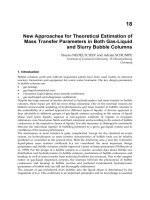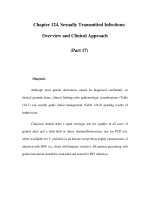Chapter 124. Sexually Transmitted Infections: Overview and Clinical Approach (Part 11) ppt
Bạn đang xem bản rút gọn của tài liệu. Xem và tải ngay bản đầy đủ của tài liệu tại đây (73.31 KB, 5 trang )
Chapter 124. Sexually Transmitted Infections:
Overview and Clinical Approach
(Part 11)
Other Causes of Vaginal Discharge or Vaginitis
In the ulcerative vaginitis associated with staphylococcal toxic shock
syndrome, Staphylococcus aureus should be promptly identified in vaginal fluid
by Gram's stain and by culture. In desquamative inflammatory vaginitis, smears of
vaginal fluid reveal neutrophils, massive vaginal epithelial-cell exfoliation with
increased numbers of parabasal cells, and gram-positive cocci; this syndrome may
respond to treatment with 2% clindamycin cream. Additional causes of vaginitis
and vulvovaginal symptoms include retained foreign bodies (e.g., tampons),
cervical caps, vaginal spermicides, vaginal antiseptic preparations or douches,
vaginal epithelial atrophy (in postmenopausal women or during prolonged breast-
feeding in the postpartum period), allergic reactions to latex condoms, vaginal
aphthae associated with HIV infection or Behçet's syndrome, and vestibulitis (a
poorly understood syndrome).
Mucopurulent Cervicitis
Mucopurulent cervicitis (MPC) refers to inflammation of the columnar
epithelium and subepithelium of the endocervix and of any contiguous columnar
epithelium that lies exposed in an ectopic position on the exocervix. MPC in
women represents the "silent partner" of urethritis in men, being equally common
and often caused by the same agents (N. gonorrhoeae, C. trachomatis, or—as
shown by case-control studies—M. genitalium); however, MPC is more difficult
than urethritis to recognize. As the most common manifestation of these serious
bacterial infections in women, MPC can be a harbinger or sign of upper genital
tract infection, also known as pelvic inflammatory disease (PID; see below). In
pregnant women, MPC can lead to obstetric complications. In a prospective study
in Seattle of 167 consecutive patients with MPC [defined on the basis of yellow
endocervical mucopus or ≥30 polymorphonuclear leukocytes (PMNs)/1000x
microscopic field] who were seen at STD clinics during the 1980s, slightly more
than one-third of cervicovaginal specimens tested for C. trachomatis, N.
gonorrhoeae, M. genitalium, HSV, and T. vaginalis revealed no identifiable
etiology (Fig. 124-4).
Figure 124-4
Organisms detected among female STD clinic patients
with
mucopurulent cervicitis (n = 167). GC, gonococcus; CT, Chlamydia trachomatis
;
MG, Mycoplasma genitalium; TV, Trichomonas vaginalis
; HSV, herpes simplex
virus. (Courtesy of Dr. Lisa Manhart; with permission.)
The diagnosis of MPC rests on the detection of yellow mucopurulent
discharge from the cervical os or of increased numbers of PMNs in Gram's-stained
or Papanicolaou-stained smears of endocervical mucus. MPC due to C.
trachomatis can also produce edematous cervical ectopy (see below) and
endocervical bleeding upon gentle swabbing.
Unlike the endocervicitis produced by gonococcal or chlamydial infection,
cervicitis caused by HSV produces ulcerative lesions on the stratified squamous
epithelium of the exocervix as well as on the columnar epithelium. Yellow
cervical mucus on a white swab removed from the endocervix indicates the
presence of PMNs.
The mucus should be rolled thinly on a slide for Gram's staining. The
presence of ≥20 PMNs/1000x microscopic field within strands of cervical mucus
not contaminated by vaginal squamous epithelial cells or vaginal bacteria indicates
endocervicitis (Fig. 124-5).
Detection of intracellular gram-negative diplococci in carefully collected
endocervical mucus is quite specific but ≤50% sensitive for gonorrhea. Therefore,
specific and sensitive tests for N. gonorrhoeae as well as for C. trachomatis (e.g.,
NAATs) are also indicated in the evaluation of MPC.









